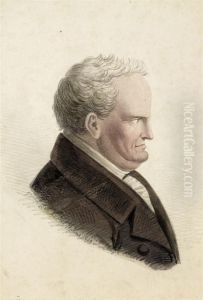Karl Alexander Heideloff Paintings
Karl Alexander Heideloff was a German architect, preservationist, and artist, born in 1792 in Nuremberg, Germany. He came from a family with artistic roots; his father was an engraver and his brother a painter, thus fostering an environment that nurtured his creative development. Heideloff's contributions to art and architecture were particularly influential in the early to mid-19th century, during a period that saw a resurgence of interest in medieval and Gothic styles, known as the Gothic Revival.
Heideloff's education included studying architecture, which was a natural choice given his family's artistic inclinations. He became one of the proponents of the Gothic Revival in Germany, advocating for the return to and appreciation of Gothic architectural principles, which he saw as a purer form of Germanic expression. His work often merged the technical aspects of architecture with the aesthetic sensibilities of an artist, which is evident in his drawings and engravings that depict medieval architecture with remarkable detail and romantic flair.
Aside from his architectural pursuits, Heideloff was deeply involved in the preservation of historic buildings. During a time when many medieval structures were in disrepair or being demolished, Heideloff worked to document and preserve these edifices. He was known for his meticulous studies of historic architecture and contributed significantly to the field of monument conservation in Germany.
One of his notable projects includes the 'Costumes of the Middle Ages', which was published in the 1830s and showcased his interest in medieval life and traditions. This work reflected his broader concern with the past and its cultural legacy, and it played a part in the 19th-century romanticism that idealized medieval times.
Heideloff's influence extended beyond his immediate professional work; he was also a teacher and mentor to many young architects and artists. Through his teachings and publications, he helped disseminate the principles of the Gothic Revival and the importance of cultural heritage preservation to a wider audience.
Karl Alexander Heideloff passed away in 1865, but his legacy lives on through his contributions to the architectural heritage and the preservation community. His work remains a testament to the importance of looking to the past to inform present and future artistic and architectural endeavors.
